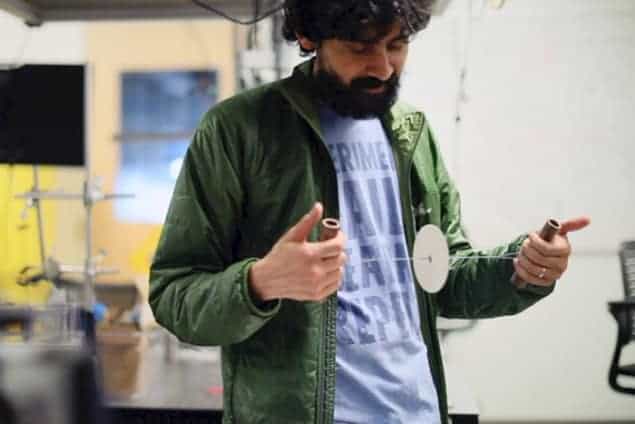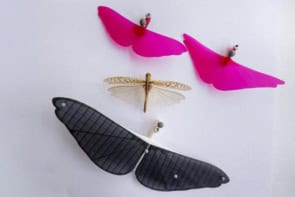
A human-powered centrifuge made of paper can generate centrifugal forces of 30,000 g and separate blood into its component parts in less than two minutes. Created by a team of biophysicists and bioengineers at Stanford University in the US, the “paperfuge” costs just $0.20 and is inspired by an ancient whirligig toy. The researchers say the device could be used for disease diagnostics in remote locations, where standard centrifuges are impractical.
Centrifuges spin tubes of biological fluids such as blood and urine at extremely high speeds. This is done to separate them into their individual components or concentrate parasites and pathogens, to enable further analysis, and is vital for diagnosing many diseases. “Centrifugation is at the heart of many diagnostics labs, and is used in many sample-preparation techniques in biology,” says Manu Prakash, whose lab at Stanford focuses on frugal science.
Commercial centrifuges are expensive and heavy, and require electricity. This makes them impractical in rural regions of the developing world where resources are limited. This has hindered the development of point-of-care diagnostics for key global health issues, such as malaria, HIV and tuberculosis, in the communities where they are most needed. Human-powered centrifuges have been developed from household items such as eggbeaters and salad spinners, but the centrifugal forces generated by these devices are low compared with laboratory centrifuges.
To address this issue, Prakash and colleagues thought about adapting spinning toys, such as yo-yos and spinning tops. When they looked a whirligigs – circular discs spun by pulling on strings passing through their centre – they realised they were rotating at speeds of up to 15,000 rpm.
Astonishing speed
To use a whirligig, you rhythmically pull on each end of a loop of string that passes through two holes in the centre of a disc. As the string coils and uncoils around itself, the disc spins at an astonishing speed. Variations of this simple toy have been found at archaeological sites all over the world, with some dating back to the Early Bronze Age, around 3300 BC.
Although whirligigs are ubiquitous, few people have studied their fundamental physics. The researchers created theoretical models of whirligigs so they could study key parameters, such as string radius and length, disc radius and the position of the holes, to optimize both the rotational speed and centrifugal force.
There is a significant need for centrifuges in low-resource settings
Rebecca Richards-Kortum, Rice University
The resulting device consists of two 10 cm-diameter discs of stiff waterproof paper, each with two 3 mm-diameter holes, spaced 2.5 mm apart, in the centre. The string is threaded through the holes and each end is tied around a wooden handle. One of the discs has two pieces of drinking straw, each sealed with glue at one end, glued to it to hold small tubes containing the biological fluids. Finally, the paper discs are held together with Velcro.
“Under a tree”
“This device is primarily designed to operate in field conditions, literally under a tree, places that lack traditional infrastructure such as roads or electricity,” Prakash told Physics World.
A high-speed camera showed that the human-powered centrifuge could reach rotational speeds of 125,000 rpm, generating centrifugal forces of 30,000 g. This is faster than many commercial centrifuges, yet the device costs just a fraction of a dollar to make.
In tests, the paperfuge could separate plasma from blood samples in 1.5 minutes, a task that took two minutes with a $700 commercial centrifuge. And it is capable of isolating malaria parasites from 30 μl of blood in 15 minutes, with comparable results to the commercial centrifuge, demonstrating that it could be used for infectious-disease diagnostics.
“A standard whirligig does not achieve the kind of specifications that we demonstrate in this paper,” Prakash told Physics World. “It’s only by truly understanding the physics of this old toy that we are able to achieve the level of functionality that can enable separation of samples to such an extent.”
Rebecca Richards-Kortum, a bioengineer and expert in health technology for low-resource settings at Rice University in the US, told Physics World that “there is a significant need for centrifuges in low-resource settings.”
Challenges remain
“The paperfuge is an important step forward, but I think challenges remain to successfully integrate it into the clinical workflow of more complex assays,” she says. “Many other diagnostics require safe transfer of plasma from the capillary tube to a paper or plastic device for subsequent analysis and it is not yet clear how to do this. Assay designers need to consider how to ensure that users correctly operate the device – will operators reliably spin all blood samples for the full 1.5 minutes?” She adds that “further considerations are needed to ensure user safety during the high-speed rotation of potentially infectious fluids.”
Prakash and colleagues are currently testing the paperfuge in rural Madagascar, to see if it can be used for malaria diagnostics. They describe their findings in Nature Biomedical Engineering.



